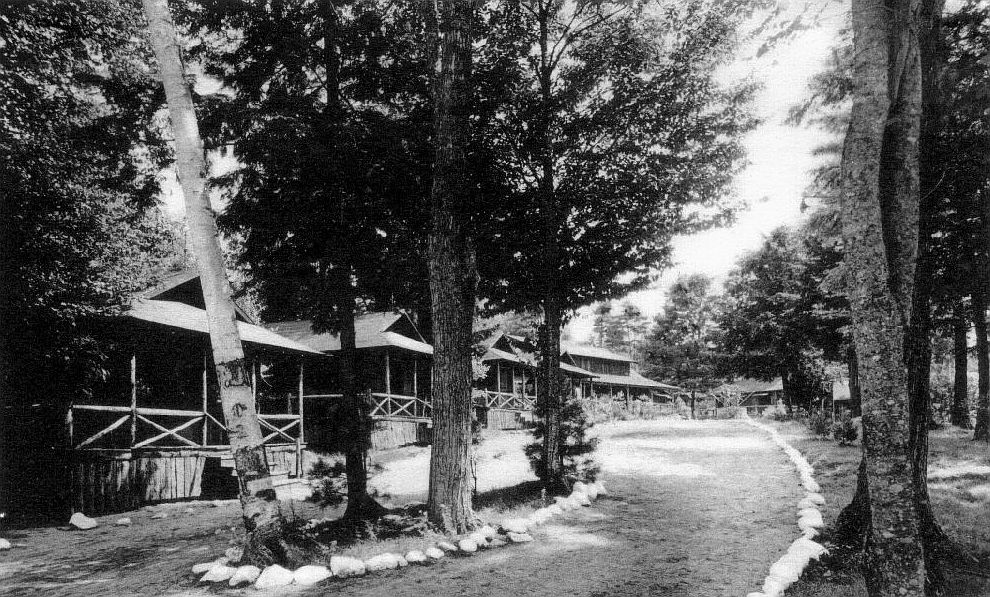
Memories of Camp Belgrade, 1937–1976

Camp Belgrade for boys was founded in 1937 by Mort and Vera Eiseman, who owned and ran the camp for the next 40 years. It was located on the site of the former girls’ Camp Jo‑Lee, which existed in the early 1900s. It covered approximately 150 acres from Route 8 down to Great Pond. It had two sandy beaches, docks and floats, tennis courts, a basketball court, a baseball field, a softball/soccer field, a riflery range, a nature hut with live animals, an arts and crafts building, a council ring, and in the early days, a chemistry lab and a boxing ring.
One of the larger buildings was a lodge where original plays were put on, movies shown, and camp dances held. Rows of individual cabins (bunks) for approximately 150 boys were located along pathways lined with white rocks. A main building housed the dining room, kitchen, and dorm upstairs for support staff. The camp also had a shower house and onsite laundry. There were three canoe sheds holding Old Town canoes, a fleet of sturdy wooden row boats, sailboats, and a bath house for boys to change into swim suits at the larger beach and water skiing at the smaller beach.

Campers were called to each activity and meals by the ringing of a large iron bell at The Well in front of the dining hall building, called the Mess Hall. At the end of the day, a camper player “Taps” on a bugle.
A live-in doctor and nurse were on duty at all times, at the infirmary building. In addition, the camp had a fulltime chef and baker in residence. In 1961, a fire destroyed the main building, which was rebuilt with the dormitory and shower house in a different location. The laundry was not rebuilt.
Campers, ages 8–15, came from most of the large cities and suburbs along the East Coast, from Boston to Norfolk, VA, Pittsburgh, and north to Canada. Some campers also came from as far away as Chicago and other Mid-West cities. Campers were predominantly Jewish from upper middle class families. In the early days, campers arrived by a special camp train, which stopped at the old North Belgrade train station, which stopped at the old North Belgrade train station, now a church. (Editor’s Note: The station was located at the bottom of Station Road, next to the tracks that still run along the western shore of Messalonskee Lake. In the 1950s, after passenger service on the line had ceased, the station building was moved two fifths of a mile to the top of the road, where, until a couple years ago, it was used as a church.)

Each summer was a full 8-week session and included instruction in all land and water sports, as well as the option for camping trips varying from mountain climbing to week-long canoeing on the Allagash with a Maine Guide and other canoe trips, deep sea fishing, or trips by bus to Quebec City for older campers. During the last week of camp, competition between two teams, Beavers and Eagles, took place, called Fun Week. Large signs appeared, made by the campers, to announce various activities and games.
Counselors, who slept in the bunks with campers, often were teachers and coaches during the school year. College students, all over 21, were also hired. For several years, exchange students from England worked at the camp. All had experience in their sport and were trained to work with children. Many had been campers and “graduated” through the ranks to become counselors, going through the training program as Training-in-Counseloring (TICs) and Counselor Assistants (CAs), staying on for many summers. Camp Belgrade became an integral part of the lives of many families, often with second generation campers attending.

Each camper and counselor made his own plaque which was hung on the walls and rafters of the Lodge. A star was added for each year the person attended camp. In addition, an annual magazine called The Sachem was produced with articles about each activity, special events, trips, and information about campers and counselors in each bunk. Camp photos were taken yearly.
The Eisemans, who had a house on the campus, eventually sold the camp after the 1976 season to a former camper and his son, but that was not successful, and the camp closed for good in 1983. The property ultimately became the yearround community called Loon Cove.
Not only did the campers and counselors have a strong connection to Camp Belgrade and the area, but so do the current Eiseman family descendants. Mort and Vera’s three grandsons attended the camp, and one of their twin daughters owns a summer home nearby on Great Pond within view of the old campsite.


Download Full Newspaper: High Res | Low Res (Details…)
<— Summaries • Next Article —>
©2023 by Summertime in the Belgrades. All rights reserved.